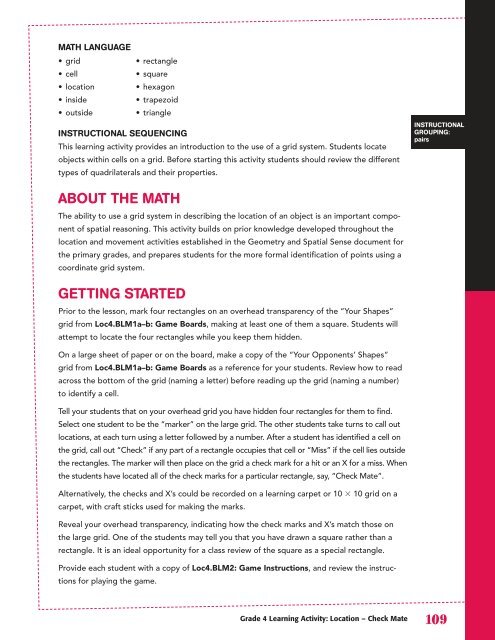Geometry and Spatial Sense, Grades 4 to 6 - EduGains
Geometry and Spatial Sense, Grades 4 to 6 - EduGains
Geometry and Spatial Sense, Grades 4 to 6 - EduGains
Create successful ePaper yourself
Turn your PDF publications into a flip-book with our unique Google optimized e-Paper software.
MATH LANGUAGE<br />
• grid<br />
• cell<br />
• location<br />
• inside<br />
• outside<br />
• rectangle<br />
• square<br />
• hexagon<br />
• trapezoid<br />
• triangle<br />
INSTRUCTIONAL SEqUENCING<br />
This learning activity provides an introduction <strong>to</strong> the use of a grid system. Students locate<br />
objects within cells on a grid. Before starting this activity students should review the different<br />
types of quadrilaterals <strong>and</strong> their properties.<br />
ABOUT THE MATH<br />
The ability <strong>to</strong> use a grid system in describing the location of an object is an important compo-<br />
nent of spatial reasoning. This activity builds on prior knowledge developed throughout the<br />
location <strong>and</strong> movement activities established in the <strong>Geometry</strong> <strong>and</strong> <strong>Spatial</strong> <strong>Sense</strong> document for<br />
the primary grades, <strong>and</strong> prepares students for the more formal identification of points using a<br />
coordinate grid system.<br />
GETTING STARTED<br />
Prior <strong>to</strong> the lesson, mark four rectangles on an overhead transparency of the “Your Shapes”<br />
grid from Loc4.BLM1a–b: Game Boards, making at least one of them a square. Students will<br />
attempt <strong>to</strong> locate the four rectangles while you keep them hidden.<br />
On a large sheet of paper or on the board, make a copy of the “Your Opponents’ Shapes”<br />
grid from Loc4.BLM1a–b: Game Boards as a reference for your students. Review how <strong>to</strong> read<br />
across the bot<strong>to</strong>m of the grid (naming a letter) before reading up the grid (naming a number)<br />
<strong>to</strong> identify a cell.<br />
Tell your students that on your overhead grid you have hidden four rectangles for them <strong>to</strong> find.<br />
Select one student <strong>to</strong> be the “marker” on the large grid. The other students take turns <strong>to</strong> call out<br />
locations, at each turn using a letter followed by a number. After a student has identified a cell on<br />
the grid, call out “Check” if any part of a rectangle occupies that cell or “Miss” if the cell lies outside<br />
the rectangles. The marker will then place on the grid a check mark for a hit or an X for a miss. When<br />
the students have located all of the check marks for a particular rectangle, say, “Check Mate”.<br />
Alternatively, the checks <strong>and</strong> X’s could be recorded on a learning carpet or 10 10 grid on a<br />
carpet, with craft sticks used for making the marks.<br />
Reveal your overhead transparency, indicating how the check marks <strong>and</strong> X’s match those on<br />
the large grid. One of the students may tell you that you have drawn a square rather than a<br />
rectangle. It is an ideal opportunity for a class review of the square as a special rectangle.<br />
Provide each student with a copy of Loc4.BLM2: Game Instructions, <strong>and</strong> review the instruc-<br />
tions for playing the game.<br />
INSTRUCTIONAL<br />
GROUPING:<br />
pairs<br />
Grade 4 Learning Activity: Location – Check Mate 10

















